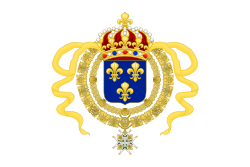Isle Saint-Jean
This article relies largely or entirely on a single source. (March 2025) |
Isle Saint-Jean | |
|---|---|
| 1713–1763 | |
Motto:
| |
 Map of the colony. | |
| Status | Colony of France within New France (1535–1758) Under British military occupation (1758–1763) |
| Capital | Port-la-Joye |
| Official languages | French |
| Religion | Catholicism |
| Government | Monarchy |
| King of France | |
• 1534–1547 | Francis I (first) |
• 1715–1763 | Louis XV (last) |
| Viceroy of New France | |
• 1534–1541 | Jacques Cartier (first; as Governor of New France) |
• 1755–1760 | Pierre de Rigaud de Vaudreuil (last) |
| History | |
• Established | 1713 |
• Disestablished | 1763 |
| Currency | Livre tournois |
| Today part of | Canada (Prince Edward Island) |

Isle Saint-Jean or Île Saint-Jean (lit. 'Saint-John Island') was a French colony in North America that existed from 1713 to 1763 on what is today Prince Edward Island as part of the wider colony of Acadia.
Colony Formation
[edit]After 1713, France engaged in a reaffirmation of its territory in Maritime North America. Besides the construction of Acadian settlement of Louisbourg on Cape Breton Island, France was resolved to organize a colony on Isle Saint-Jean.
The beginning of the colony was slow, with only 297 inhabitants by 1728. During the years 1740–1750, hundreds of Acadians fled Nova Scotia, which had been conquered by the British in 1713, to exile themselves on this island. The colony population increased to 4,000 inhabitants by 1755.
Deportation
[edit]After Louisbourg had fallen to the British on July 26, 1758, during the French and Indian War, the order of deportation was given two weeks later to the Acadians of Isle Saint-Jean, and the Ile Saint-Jean Campaign began. The British authorities had decided to forgo the initiative to assimilate them in the British colonies, and wanted them returned to France. Around 4,600 Acadiens lived on Isle Saint-Jean.
In August 1758, 3,100 inhabitants were captured and deported to France. Others succeeded in hiding or fleeing. Of the twelve ships used to transport the Acadians, three sank; Duke William (364 died), Violet (280 died) and Ruby (213 died). In all, 1,649 Acadians, around 53% of the total number deported, died from drowning or diseases.[6]
In 1763, France ceded the Isle Saint-Jean officially to Great Britain, with the Treaty of Paris.
Notes
[edit]- ^ Lesser version of the coat of arms as used by the French Government.
- ^ The Royal Banner of early modern France or "Bourbon Flag" was the most commonly used flag in New France[1][2][3][4][5]
References
[edit]- ^ The Governor General of Canada (12 November 2020). "Royal Banner of France – Heritage Emblem". Confirmation of the blazon of a Flag. February 15, 2008 Vol. V, p. 202. The Office of the Secretary to the Governor General.
- ^ New York State Historical Association (1915). Proceedings of the New York State Historical Association with the Quarterly Journal: 2nd–21st Annual Meeting with a List of New Members. The Association.
It is most probable that the Bourbon Flag was used during the greater part of the occupancy of the French in the region extending southwest from the St. Lawrence to the Mississippi, known as New France... The French flag was probably blue at that time with three golden fleur-de-lis ....
- ^ "Background: The First National Flags". The Canadian Encyclopedia. 2019. Retrieved 1 March 2021.
At the time of New France (1534 to the 1760s), two flags could be viewed as having national status. The first was the banner of France – a blue square flag bearing three gold fleurs-de-lys. It was flown above fortifications in the early years of the colony. For instance, it was flown above the lodgings of Pierre Du Gua de Monts at Île Sainte-Croix in 1604. There is some evidence that the banner also flew above Samuel de Champlain's habitation in 1608. ... the completely white flag of the French Royal Navy was flown from ships, forts and sometimes at land-claiming ceremonies.
- ^ "INQUINTE.CA | CANADA 150 Years of History ~ The story behind the flag". inquinte.ca.
When Canada was settled as part of France and dubbed "New France," two flags gained national status. One was the Royal Banner of France. This featured a blue background with three gold fleurs-de-lis. A white flag of the French Royal Navy was also flown from ships and forts and sometimes flown at land-claiming ceremonies.
- ^ Wallace, W. Stewart (1948). "Flag of New France". The Encyclopedia of Canada. Vol. II. Toronto: University Associates of Canada. pp. 350–351.
During the French régime in Canada, there does not appear to have been any French national flag in the modern sense of the term. The "Banner of France", which was composed of fleur-de-lys on a blue field, came nearest to being a national flag, since it was carried before the king when he marched to battle, and thus in some sense symbolized the kingdom of France. During the later period of French rule, it would seem that the emblem...was a flag showing the fleur-de-lys on a white ground... as seen in Florida. There were, however, 68 flags authorized for various services by Louis XIV in 1661; and a number of these were doubtless used in New France
- ^ R.R. Palmer, A History of the Modern World 2nd ed. 1961, p. 234.



![Coat of arms of New France[a] of New France](http://upload.wikimedia.org/wikipedia/commons/thumb/1/14/Coat_of_Arms_of_Kingdom_of_France.svg/120px-Coat_of_Arms_of_Kingdom_of_France.svg.png)